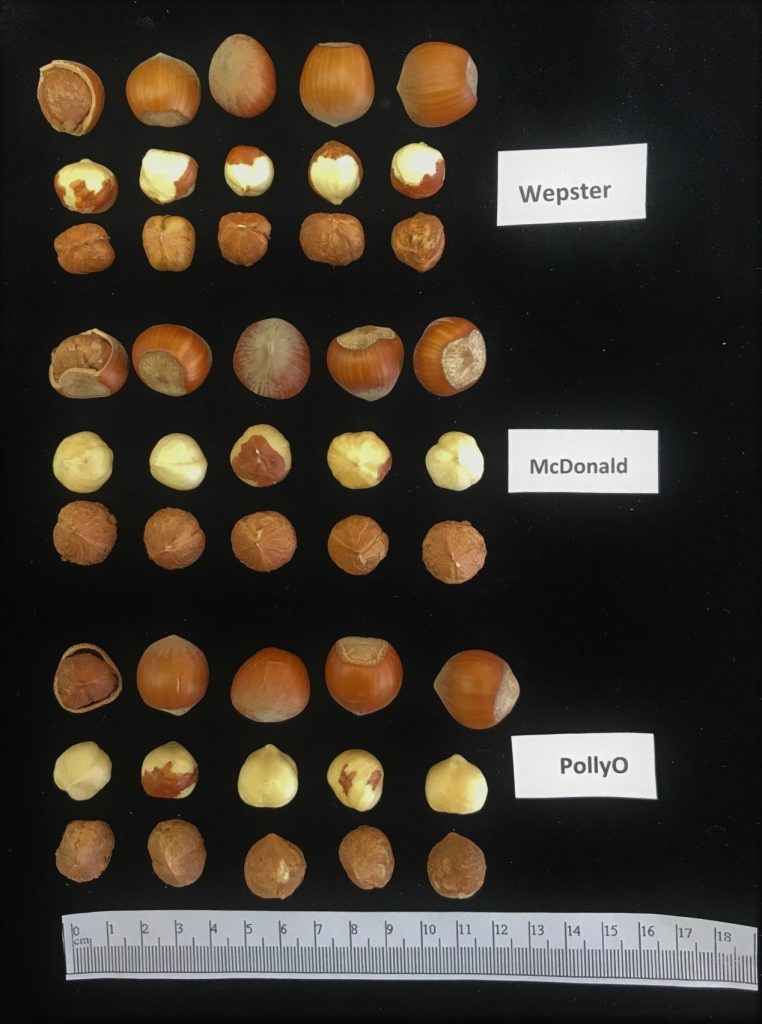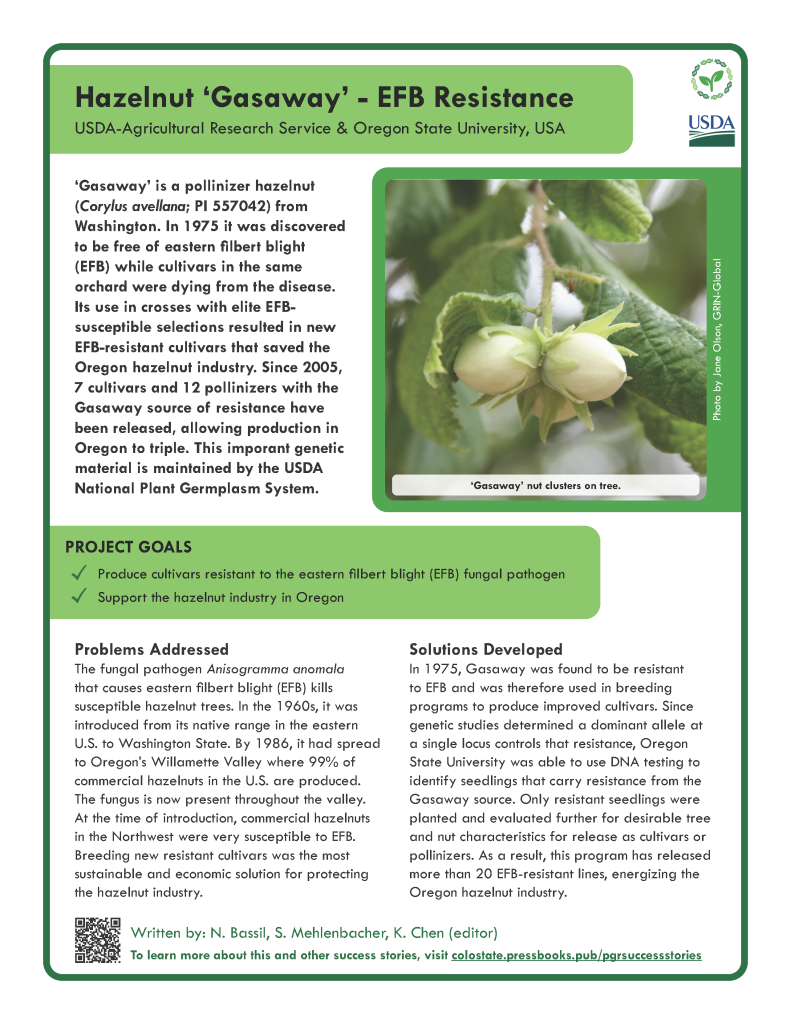Fruits and Nuts
Hazelnut ‘Gasaway’ – EFB Resistance
GASAWAY: A HAZELNUT SELECTION THAT SAVED THE OREGON HAZELNUT INDUSTRY
Nahla Bassil and Shawn Mehlenbacher
USDA-ARS National Clonal Germplasm Repository, 33447 Peoria Rd, Corvallis, Oregon 97333.
Horticultural Sciences Department, Oregon State University, 2750 SW Campus Way, Corvallis, Oregon 97330.
Corresponding author: nahla.bassil@usda.gov
OUTLINE
- Summary
- Problems addressed
- Solutions developed
- Impact
- Germplasm
- Additional resources
- Chapter information
1. SUMMARY

‘Gasaway’ is a pollinizer hazelnut (Corylus avellana; PI 557042) cultivar with small nuts and low yield from southwest Washington State. In 1975 it was discovered to be free of eastern filbert blight (EFB) while cultivar ‘DuChilly’ was dying from the disease in the same orchard. Its use in crosses with elite EFB-susceptible selections, later supplemented by use of DNA tests to advance only EFB resistant seedlings for further tree and nut evaluations, resulted in new EFB-resistant cultivars that saved the Oregon hazelnut industry. Since 2005, seven cultivars and twelve pollinizers with the ‘Gasaway’ source of resistance have been released and 56,000 new acres have been planted in Oregon, tripling the production acreage. Currently there are 94,000 acres of hazelnut orchards in Oregon. As an important source of disease resistance, ‘Gasaway’ germplasm is safeguarded by the USDA National Plant Germplasm System.
The goal was to produce improved cultivars that are resistant to the devastating eastern filbert blight (EFB) fungal pathogen and support the hazelnut industry in Oregon.
Download a printable fact sheet by clicking the image below.
2. PROBLEMS ADDRESSED

The fungal pathogen Anisogramma anomala that causes eastern filbert blight (EFB) kills susceptible trees. It is native to the eastern U.S., where it causes minor damage on wild Corylus americana, and was introduced to southwest Washington State around 1960. In 1986, it was found in the Willamette Valley where 99% of commercial hazelnuts in the U.S. are produced. The fungus is now present throughout the valley. The cultivars growing in Oregon before 2005 were susceptible to EFB. The breeding of new resistant cultivars was the most sustainable and economic solution.
3. SOLUTIONS DEVELOPED

Genetic studies determined that a dominant allele at a single locus controls resistance from ‘Gasaway’. DNA tests were developed, and since 1998 the Oregon State University hazelnut breeding program has been routinely using two DNA tests to identify young seedlings that carry resistance from the ‘Gasaway’ source. Susceptible seedlings were discarded and only resistant seedlings were planted and evaluated further for desirable tree and nut characteristics for release as cultivars or as pollinizers. Since 1990, seven cultivars, 12 pollinizers, and two ornamentals with ‘Gasaway’ resistance have been released (Table 1).
| Pollinizer | Year | Nut Cultivar | Year | Ornamental | Year |
| VR 4-31 | 1990 | Santiam | 2005 | Red Dragon | 2008 |
| VR 11-27 | 1990 | Yamhill | 2008 | Burgundy Lace | 2015 |
| VR 20-11 | 1990 | Jefferson | 2009 | ||
| VR 23-18 | 1990 | Dorris | 2012 | ||
| Gamma | 2002 | Wepster | 2013 | ||
| Delta | 2002 | McDonald | 2014 | ||
| Epsilon | 2002 | PollyO | 2018 | ||
| Zeta | 2002 | ||||
| Eta | 2009 | ||||
| Theta | 2009 | ||||
| York | 2012 | ||||
| Felix | 2012 |
Collaborators involved in developing solution:
- Joseph Postman and Lauri Reinhold, USDA-ARS NCGR, Corvallis, Oregon, USA
- Maxine Thompson, Oregon State University, Corvallis, Oregon, USA
4. IMPACT

These new EFB-resistant cultivars have energized the Oregon hazelnut industry with farmers transitioning from other crops like caneberries and grass seed to hazelnuts. The hazelnut acreage in Oregon increased from 29,000 in 2009 to 94,000 acres today. In the last 10 years, the number of growers in western Oregon has jumped from 500 to more than 900, with up to 1,200 attending meetings of the Nut Growers Society. Furthermore, Oregon hazelnut production value from 2020 was $132.3 million according to the 2022 version of the Oregon Agricultural Statistics & Directory.
5. GERMPLASM
‘Gasaway’ (PI 557042) originated in Battle Ground, Washington by Richard Gasaway. It was introduced in 1926 by Carroll D. Bush Nurseries in Barton, Oregon. ‘Gasaway’ was donated to the USDA National Plant Germplasm System by former Oregon State University breeder Maxine Thompson in 1981.
‘Gasaway’ nuts are small (1.5 g), long, light gray, and pubescent. Kernel weight is 47% of total nut. The kernel is fibrous, and the pellicle is not removed by dry heat. The husk is half as long as the nut, and nuts fall free of the husk at maturity. Highly resistant to eastern filbert blight and resistant to big bud mite. Sets many catkins, which shed pollen late in the season. Has S3 & S26 incompatibility alleles.
More information can be found at GRIN-Global: PI 557042.
6. ADDITIONAL RESOURCES
Hummer KE, Postman J. 2020. Guardians of the germplasm: hazelnuts, berries, pears, hops and mint. Journal of the American Pomological Society 74:104-110.
Mehlenbacher SA, Thompson MM, Cameron HR. 1991. Occurrence and inheritance of immunity to eastern filbert blight in ‘Gasaway’ hazelnut. HortScience 26:410-411.
Smith DC, Mehlenbacher SA. 2023. Hazelnut genetic improvement at Oregon State University, a summary of the breeding effort since 1969. Acta Horticulurae 1379:35-40. https://doi.org/10.17660/ActaHortic.2023.1379.6
The Brooks and Olmo Register of Fruit and Nut Varieties. 1997. 3rd Ed. ASHS Press Alexandria, Virginia, USA.
7. CHAPTER INFORMATION
Citation: Bassil N, Mehlenbacher S. 2023. Hazelnut ‘Gasaway’ – EFB Resistance. In: Volk GM, Chen K, Byrne P (Eds.) Plant Genetic Resources: Success Stories. Fort Collins, Colorado: Colorado State University. Date accessed. Available from https://colostate.pressbooks.pub/pgrsuccessstories/chapter/hazelnut-gasaway-efb-resistance/
Content originally submitted: April 19, 2023
Date of publication: July 2023
USDA is an equal opportunity provider, employer, and lender. Mention of trade names or commercial products in this article is solely for the purpose of providing specific information and does not imply recommendation or endorsement by the U.S. Department of Agriculture.


